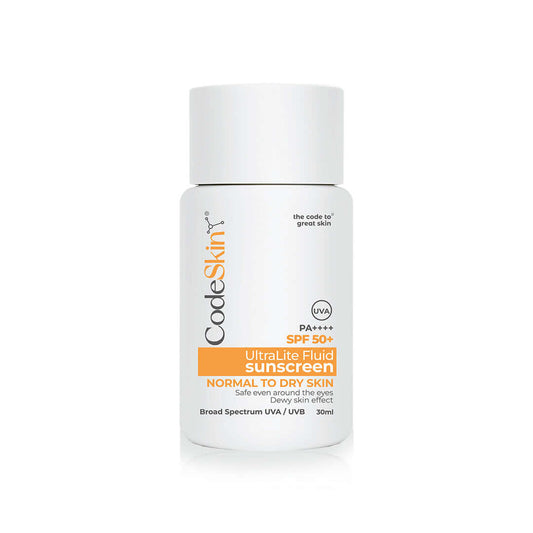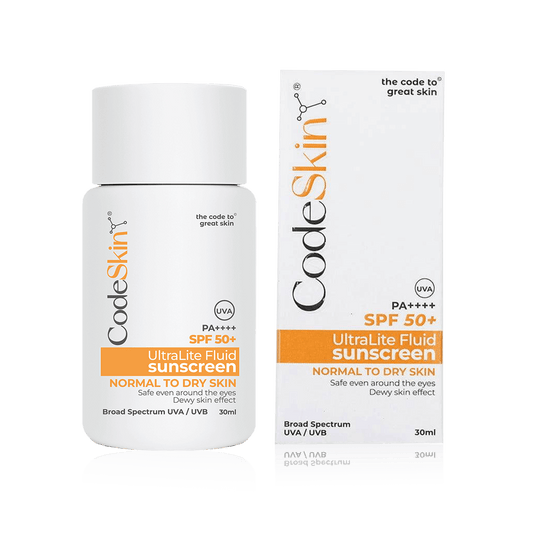-

 For Hyperpigmentation/ Melasma
For Hyperpigmentation/ MelasmaUltraProtect Fluid Sunscreen | SPF 100+ PA++++
12hr Strong Sun Protection | Dewy Fluid Texture | Sweat/Water-Resistant For 80 MinsPenta Filter TechnologyRegular price ₹ 500Regular priceUnit price per -

 For A Non-Heavy Finish
For A Non-Heavy FinishUltraLite Fluid Sunscreen | SPF 50+ PA++++
Feels Invisible & Lightweight | Dewy Fluid Texture | Sweat/Water-Resistant For 80 MinsHydrating Prebiotics | NiacinamideRegular price ₹ 500Regular priceUnit price per
Sunscreen for Normal Skin - Balanced Protection for Every Day
If you have normal skin, consider yourself lucky, it’s often the easiest type to manage. But even with skin that doesn’t lean too dry or oily, sunscreen remains a crucial part of your daily routine. Sun exposure can affect all skin types. So, keeping your normal skin protected is essential for maintaining its natural balance and youthful glow.
In this blog, we will discuss all that you should know about sunscreen for normal skin.
Features of Sunblock for Normal Skin
When it comes to keeping normal skin protected and healthy, the best sunscreen offers a range of beneficial features. Let's explore what makes these sunscreens ideal for daily use.
- Ingredients:
The best sunscreen for normal skin has mineral ingredients, such as titanium dioxide or zinc oxide. These ingredients create a physical barrier on the surface of the skin, providing effective protection without causing irritation or imbalance.
- The process:
This sunscreen reflects and then scatters UV radiation away from the skin, ensuring broad-spectrum protection. It does this without being absorbed into the skin, making it suitable for normal skin types that need balanced protection.
- Cosmetic Properties:
Sunscreen formulated for normal skin often has a lightweight, non-greasy texture. However, it may leave a slight white cast due to the mineral particles. Advanced formulations aim to minimize this effect, ensuring a smooth and natural finish.
- Reapplication:
One of the advantages of using sunscreen for normal skin is that it usually requires fewer frequent reapplication compared to chemical sunscreens. The physical barrier remains intact longer, providing continuous protection throughout your day.
Tips for Finding Out Your Skin Type
Understanding your skin type is essential for choosing the right skincare products, including sunscreen. Here are some easy tips to help you determine your skin type:
- Observe Your Skin:
Pay attention to how your skin feels after cleansing. If it feels tight and dry, you might have dry skin. If it feels shiny and greasy, you likely have oily skin. If it feels comfortable and balanced, you probably have normal skin.
- Blotting Paper Test:
Press a clean blotting paper against different areas of your face. If the paper picks up oil from all areas, you have oily skin. If it picks up oil from only the T-zone (forehead, nose, and chin), you have combination skin. In case it picks up little to no oil, you have dry or normal skin.
- Touch and Feel:
Gently touch your face. If your skin feels rough or flaky, you have dry skin. If it feels smooth and even, you likely have normal skin. If it feels oily or sticky, you have oily skin.
- Reaction to Products:
Take note of how your skin reacts to different products. If your skin often feels irritated or sensitive, you may have sensitive skin. If it generally tolerates products well without significant reactions, you have normal skin.
How to Apply Sunscreen for Normal Skin
Applying sunscreen correctly is essential for protecting your skin from harmful UV rays. Here’s a step-by-step guide on how to use sunscreen for normal skin type effectively:
- Choose the Right SPF:
Opt for an SPF for normal skin of at least 30. This level provides adequate protection against both UVA and UVB rays, ensuring your skin stays safe.
- Cleanse and Moisturize:
Start with a clean face. Use a gentle cleanser suitable for sunscreen normal skin and follow up with a lightweight moisturizer if needed. Allow the moisturizer to absorb fully before applying sunscreen.
- Apply Generously:
Take a sufficient amount of sunscreen for normal skin and apply it evenly across your face and neck. Don’t forget areas like your ears, the back of your neck, and any other exposed skin.
- Use Upward Strokes:
Gently spread the sun screen for normal skin using upward strokes. This ensures even coverage and helps the sunscreen absorb better into your skin.
- Allow Time to Absorb
Give the sunscreen at least 15-20 minutes to fully absorb into your skin before stepping outside. This ensures maximum effectiveness.
- Reapply Regularly
Reapply your sunscreen every two hours, especially if you’re spending extended periods outdoors. If you’re swimming or sweating, use a water-resistant sunscreen and reapply immediately after towel-drying.
How to Choose SPF for Normal Skin
Choosing the right SPF is crucial for maintaining the health and radiance of your skin. Here’s how to select the best sunscreen cream for normal skin:
- Opt for Broad-Spectrum Protection:
The best sunscreen for normal skin should offer broad-spectrum protection. This means it protects against both UVA and UVB rays, ensuring comprehensive coverage.
- SPF Rating:
Aim for an SPF of at least 30. This level of protection is recommended for daily use and effectively shields your skin from harmful sun exposure.
- Lightweight and Non-Greasy Formula:
The best sunscreen for normal skin should have a lightweight and non-greasy texture. This ensures it feels comfortable on your skin and absorbs quickly without leaving a heavy residue.
- Hydrating Ingredients:
Look for sunscreens that include hydrating ingredients to maintain your skin's natural moisture balance. This is especially important for keeping your skin smooth and supple throughout the day.
- Non-Comedogenic:
The best sunscreen for normal skin should be non-comedogenic, meaning it won’t clog your pores. This helps prevent breakouts and keeps your skin clear.
Common Mistakes to Avoid While using sunscreen
Some common mistakes can reduce the effectiveness of your sunscreen. Are you making these mistakes?
- Skipping Daily Use:
Sunscreen should be applied every day, regardless of the weather or your indoor/outdoor status.
- Using Insufficient Amount:
Apply a generous amount to all exposed skin. Most people use too little, reducing effectiveness.
- Forgetting to Reapply:
Reapply sunscreen every two hours, or immediately after swimming or sweating.
- Missing Spots:
Don’t forget areas like over the eye lids, the ears, neck, hands, and feet, which are often overlooked.
- Not Waiting for Absorption:
Allow sunscreen to absorb for at least 15-20 minutes before sun exposure for maximum protection.
Buy the Best Sunscreen for Normal Skin Online at CodeSkin
Shop at CodeSkin for a wide range of premium sunscreens tailored for normal skin. Get the best protection and comfort with every application!
FAQs on Sunscreen for Normal Skin
For normal skin, a lightweight, hydrating, and non-greasy sunscreen with broad-spectrum protection is ideal.
An SPF of at least 30 is recommended for normal skin to provide effective protection from UV rays.
Choose a sunscreen based on your skin type and look for broad-spectrum protection. Select a formula that matches your skin’s needs, such as hydrating for dry skin or non-greasy for oily skin.





 Home
Home Shop
Shop Profile
Profile